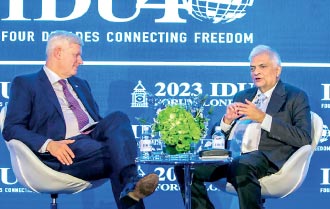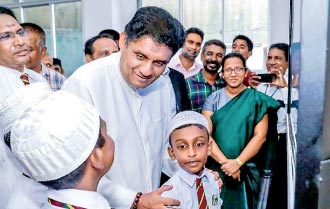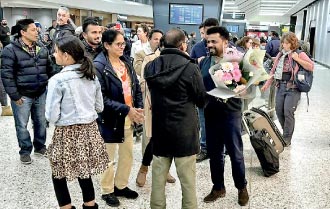Monday Dec 29, 2025
Monday Dec 29, 2025
Thursday, 29 June 2023 02:00 - - {{hitsCtrl.values.hits}}

President’s IDU discourse

Sajith's Sakvala scheme for schools

Anura arrives in Melbourne
|
“Speak out, you’ve got to speak out against The madness…”
– Crosby, Stills & Nash, ‘Long Time Gone’ (1968)
 President Wickremesinghe’s domestic debt restructuring ‘shock therapy’ which in all probability will impact negatively downstream on the EPF and ETF i.e., people’s savings, is not due so much to the IMF agreement or Paris Club pressure. It is to appease the foreign private creditors, chiefly the ISB holders.
President Wickremesinghe’s domestic debt restructuring ‘shock therapy’ which in all probability will impact negatively downstream on the EPF and ETF i.e., people’s savings, is not due so much to the IMF agreement or Paris Club pressure. It is to appease the foreign private creditors, chiefly the ISB holders.
The bulk of foreign private debt was incurred by PM Wickremesinghe and his UNP economic team in 2015-2019.
Wickremesinghe is not a popularly elected leader and has no mandate to do anything which could impact negatively on people’s savings. That would be perceived as illegitimate and as tantamount to theft.
Ranil’s main target
In the Westminster culture one is not allowed to refer to another member of Parliament by the usual appellation for anyone caught fibbing. Thus, an MP referring to his opponent of the moment had famously said “Mr. Speaker, the honorable member’s speech brings to mind an ancient Greek instrument”. The House roared with laughter because most of them had studied Classics even cursorily, and recognised the reference to the harp-like stringed musical instrument known as the “lyre” –pronounced “liar”.
I was reminded of this ancient musical instrument when reading President Ranil Wickremesinghe’s remarks at the 40th convention of the International Democratic Union (IDU 40) in London at a one-on-one with Stephen Harper the Conservative former PM of Canada. He said:
 “If I look back to May-June last year, Sri Lanka was on the verge of chaos. No one seemed willing to take charge or show leadership. I found myself in a peculiar position. In the 2019 Presidential Election, our party wanted to adopt a populist approach, so they chose our deputy leader as their candidate. Unfortunately, as I had anticipated, he suffered a significant defeat.” (Source: PMD)
“If I look back to May-June last year, Sri Lanka was on the verge of chaos. No one seemed willing to take charge or show leadership. I found myself in a peculiar position. In the 2019 Presidential Election, our party wanted to adopt a populist approach, so they chose our deputy leader as their candidate. Unfortunately, as I had anticipated, he suffered a significant defeat.” (Source: PMD)
In May-June 2022 Sri Lanka was not “on the verge of chaos” except for the economic chaos created by the crazy policies of President Gotabaya Rajapaksa whose removal the protestors were demanding. That is why Ranil Wickremesinghe was able to suggest in an interview with international TV at that time, that tourists should come and visit the Galle Face ‘Gota Go Home’ site.
If in November 2019 Ranil’s party wanted “to adopt a populist approach”, and chose its deputy leader Sajith Premadasa as candidate, it was to avoid the wipeout that Ranil Wickremesinghe would inevitably visit on them, having reduced the UNP to 23% at the February 2018 local authorities election. Dinesh Weerakkody would confirm that in his interview with the UNP’s legendary former General-Secretary Sirisena Cooray, the cover story of Business Today of January 2000, Cooray prophesied that under Ranil’s leadership with its elitist policies the UNP would be consigned for the long-term to below 25% of the vote.
Sajith Premadasa did not suffer “a significant defeat” in November 2019 as Ranil says. Having been given the nomination by Ranil well after Gotabaya Rajapaksa hit the campaign trail, Sajith fell 10% behind (scoring 42% to Gota’s 52%) missing the magic 50% by only 8%. How Ranil would have fared instead was evidenced by the fate of the UNP at the August 2020 parliamentary election, when he failed to be elected to parliament from his hometown, Colombo. Had Ranil rather than Sajith been the candidate in 2019, and had Sajith not provided an alternative by launching the SJB in 2020, Gotabaya and the Pohottuwa would have had an even greater majority and grip on the system than they obtained.
 “…Personally, I believed that we should stick with the IMF program. This program, which we had initiated in 2016, required Sri Lanka to commit to a primary surplus and reduce subsidies. We diligently worked towards these goals, and by 2018, we managed to achieve a primary surplus of USD 300 million…”
“…Personally, I believed that we should stick with the IMF program. This program, which we had initiated in 2016, required Sri Lanka to commit to a primary surplus and reduce subsidies. We diligently worked towards these goals, and by 2018, we managed to achieve a primary surplus of USD 300 million…”
Wickremesinghe seems oblivious to the likelihood that having “worked diligently” by 2018 towards the goal of “reducing subsidies” as per IMF program, enabled the infant SLPP to impose in 2018 a crushing defeat at the local government election on the UNP and SLFP despite the two major parties sharing office.
 “…some members of my own party believed that our approach was too narrow and opted for a populist stance, eventually breaking away from the party. As a result, for the first time in history, my party was left with just one member in parliament, which happened to be me. Meanwhile, the breakaway faction had gathered 50 members.”
“…some members of my own party believed that our approach was too narrow and opted for a populist stance, eventually breaking away from the party. As a result, for the first time in history, my party was left with just one member in parliament, which happened to be me. Meanwhile, the breakaway faction had gathered 50 members.”
If the sole choice had been Ranil vs Gotabaya in 2019 and Ranil vs Mahinda in 2020; if there had been no “breakaway faction” with a “populist stance”, there would have been hardly any Opposition in the parliament of 2020, resulting in a political monopoly for the Rajapaksa clan, and worse, Gotabaya’s militarist-racist praetorians.
Ranil’s IDU 40 London discourse had only one target, which wasn’t the NPP-JVP or the FSP but the ‘breakaway populist’ SJB and its leader Sajith Premadasa. Clearly Ranil sees Sajith’s SJB as his main target and challenge. He is hoping the IDU will bring pressure to bear on Sajith and/or the SJB to reunite/realign under Ranil’s leadership on the basis of supposedly shared economic ideology. If that happens and the progressive centre obliterated, the path will be cleared for an AKD-NPP-JVP victory.
The SJB’s amorphous ideology and wobbly, ‘borderless’ identity are vulnerabilities. Will Sajith sensibly differentiate the SJB from Ranil’s free-market fundamentalism by positioning himself and his party firmly on President Premadasa’s paradigm which is by no means rightist Conservative or center-right, but progressive-centrist as is that of the US Democrats, the Labour parties of UK, Australia and New Zealand, and social democrats everywhere?
Aragalaya trashed
 “…On May 9 of the previous year, riots erupted, leading to the burning of the residences of 65 government members of parliament…”
“…On May 9 of the previous year, riots erupted, leading to the burning of the residences of 65 government members of parliament…”
On May 9th 2022 “riots erupted” says Ranil, omitting to mention that the conspicuously peaceful protest had been attacked by a mob emanating from Temple Trees. When the violent attack on Galle Face Green was seen, the country erupted in violent retaliation. The sin of the Aragalaya was a sin of moral omission, not commission—it did not issue calls to circumscribe the violence or condemn it when it turned lethal.
 “…However, as we began to recover and the government started functioning, a wave of protests emerged. On July 9, a group of organizers managed to gather a significant number of people in Colombo, something unprecedented in scale. Shockingly, these protesters went on to invade the official residence of the President. Faced with this unexpected threat, the President had to flee to the harbour and board a ship belonging to the Sri Lankan Navy…”
“…However, as we began to recover and the government started functioning, a wave of protests emerged. On July 9, a group of organizers managed to gather a significant number of people in Colombo, something unprecedented in scale. Shockingly, these protesters went on to invade the official residence of the President. Faced with this unexpected threat, the President had to flee to the harbour and board a ship belonging to the Sri Lankan Navy…”
This is the grotesque untruth at the heart of Wickremesinghe’s narrative which reveals where he is coming from and where he is headed.
According to Ranil, the massive upheaval of July 9th which bloodlessly overthrew President Gotabaya Rajapaksa took place “as we began to recover and the government started functioning”. This proves that Wickremesinghe was pleased with his Prime Ministership under Gotabaya’s presidency and that the two of them had the economy in hand (“we began to recover”) because Gotabaya was taking the economic line from Ranil (another ‘Republican’).
His account is plainly untenable. “On July 9, a group of organizers managed to gather a significant number of people in Colombo, something unprecedented in scale.” Almost a million people cannot be mobilized by “a group of organizers” to march peacefully yet determinedly, in the face of armed soldiers and armoured cars, if “we began to recover” tangibly.
In Wickremesinghe’s version to IDU40 about July 9th he uses the word “however” -- meaning the climactic protest was notwithstanding and contrary to the “recovery” that had commenced. In Ranil’s mind, July 9th which displaced the irrational Gotabaya was unnecessary and unjustifiable. Soldiers cannot be made to solidarise in plain sight with protestors unless the ground was burning beneath their boots, in terms of the suffering of their families in the rural areas.
July 9th an emancipatory efflorescence more dramatic than anything we had seen before in Sri Lanka, and the world was marvelling at it because it was telecast by international networks. While most of us were experiencing a sense of liberation and enormous pride about the spirit of the Sri Lankan people; while democratic sentiment from liberal to radical all over the world was thrilled by Sri Lanka’s incandescent exercise in people’s power, removing an (elected) arrogant autocrat peacefully, Ranil Wickremesinghe was clearly “shocked”.
He found it more shocking, it seems, than Gota’s arbitrary ruination of agriculture and the peasantry which he failed to mention at IDU 40. The protestors “invaded” the official residence of the President in which they, the citizens, had installed Gotabaya Rajapaksa through their vote in 2019 in order to evict him because he had repaid their trust with exploding gas cylinders and a wrecked harvest. He had betrayed the Social Contract.
Ranil shouldn’t have found it quite that “shocking” because it had (pretty much) happened before. The year after he had accompanied his parents to the coronation of Queen Elizabeth II, the people of Ceylon launched a peaceful uprising, the Hartal of August 1953, on which the Police opened fire, killing 8 demonstrators. The mass protest caused the resignation of Prime Minister Dudley Senanayake and the evacuation of the entire UNP Cabinet onto a US ship. His successor, the right-wing martinet Sir John Kotelawala advised by Ranil father, was buried beneath an electoral avalanche in 1956.
 “…I maintained my position and refused to resign. On Monday, with the cabinet assembled, we held a televised meeting, while the President had already left the country for the Maldives. Meanwhile, the protesters resolved to seize the Prime Minister’s office and take control of Parliament. Two days later, a fierce battle ensued outside the Prime Minister’s office, lasting approximately six to five hours. Despite the escalating situation, I refrained from ordering the use of firearms. Eventually, the protesters managed to break into the Prime Minister’s office, with the military accompanying them. In the afternoon, they began marching towards Parliament…”
“…I maintained my position and refused to resign. On Monday, with the cabinet assembled, we held a televised meeting, while the President had already left the country for the Maldives. Meanwhile, the protesters resolved to seize the Prime Minister’s office and take control of Parliament. Two days later, a fierce battle ensued outside the Prime Minister’s office, lasting approximately six to five hours. Despite the escalating situation, I refrained from ordering the use of firearms. Eventually, the protesters managed to break into the Prime Minister’s office, with the military accompanying them. In the afternoon, they began marching towards Parliament…”
Does anyone in Colombo remember “a fierce battle [which] ensued outside the Prime Minister’s office, lasting approximately six to five hours”? One recalls very heavy CS-gassing which the protestors recovered from and prevailed through smart tactics. But where were the casualties of this “fierce battle …lasting approximately six to five hours”? And where is the TV or CCTV footage?
If Ranil’s version to the IDU 40 that “the protesters resolved to…take control of Parliament” was true, then logically they have done so on July 9th when there were about a million people on the march, the military was fraternizing with them (“with the military accompanying them” says Ranil), and they had already occupied/liberated the Presidential Secretariat and the President’s House. But they did not move against Parliament because they did not “resolve to take control of Parliament”.
 “Recognizing the gravity of the situation, I instructed the Chief of Defence to issue a statement, emphasizing that the protesters must not take over Parliament…I then directed the army commander, reminding him of his responsibility to protect the parliamentary building. I stressed that we could deploy the best battalion in Sri Lanka, even without arms, to confront the protesters. Remarkably, the unarmed battalion successfully managed to quell the protests, but unfortunately, 24 soldiers were injured in the process.”
“Recognizing the gravity of the situation, I instructed the Chief of Defence to issue a statement, emphasizing that the protesters must not take over Parliament…I then directed the army commander, reminding him of his responsibility to protect the parliamentary building. I stressed that we could deploy the best battalion in Sri Lanka, even without arms, to confront the protesters. Remarkably, the unarmed battalion successfully managed to quell the protests, but unfortunately, 24 soldiers were injured in the process.”
But that wasn’t July 9th, that was July 13th. There was no attempt to march on Parliament on July 9th. Furthermore, who has been arrested and tried specifically for this protest in which “24 soldiers were injured”?
On live FB feed, Wasantha Mudalige, Rathindu Seneviratne (‘Ratta’) and Rasika Jayakody urged Pathum Kerner to abandon the demonstration. If “24 soldiers were injured” assistance could surely have been rendered by Kerner who was formerly a military doctor. Currently he applauds President Wickremesinghe’s economic policies and claims he paved the way for them. I daresay he did.
 “…Soon after, we had to proceed with the presidential election. In the meantime, I took necessary steps to restore law and order. I firmly stated that these were not mere protests, but actions intended to overthrow the government and disrupt the Sri Lankan parliament…”
“…Soon after, we had to proceed with the presidential election. In the meantime, I took necessary steps to restore law and order. I firmly stated that these were not mere protests, but actions intended to overthrow the government and disrupt the Sri Lankan parliament…”
 “Although a number of protesters were initially arrested, they were later released, which only served to embolden them further. Even the presidents of the Bar Association stood in solidarity with them. Recognizing the gravity of the situation, I consulted with the Attorney General and realized that the protesters were attempting to attack Parliament. As a result, I issued detention orders and apprehended two or three individuals…Eventually, the Prime Minister’s office was cleared as the army intervened, followed by the clearance of the President’s office and residence.”
“Although a number of protesters were initially arrested, they were later released, which only served to embolden them further. Even the presidents of the Bar Association stood in solidarity with them. Recognizing the gravity of the situation, I consulted with the Attorney General and realized that the protesters were attempting to attack Parliament. As a result, I issued detention orders and apprehended two or three individuals…Eventually, the Prime Minister’s office was cleared as the army intervened, followed by the clearance of the President’s office and residence.”
 “…Once I assumed the presidency of Sri Lanka, I promptly issued an order prohibiting any form of demonstrations in the country for one week, aiming to restore peace and stability…”
“…Once I assumed the presidency of Sri Lanka, I promptly issued an order prohibiting any form of demonstrations in the country for one week, aiming to restore peace and stability…”
The remarks reveal Ranil’s contempt for the rule of (normal) law and his hatred for the Aragalaya.
The occupied buildings which had become sites visited by tens of thousands of families who picnicked peacefully on their lawns, were not “cleared as the Army intervened” as instructed by Ranil, but evacuated by the protestors themselves on the strong insistence of Bar Association President Saliya Pieris—which I regarded then and now as puzzlingly untimely, unilateral and naive. Had the occupation continued, as I had witnessed in Madrid in 2011-2012, the moment of ‘dual power’ could’ve been extended and leveraged.
1956 reloaded
At IDU40, President Wickremesinghe announced his economic intentions:
 “…However, my main focus is on completing the necessary structural reforms. I aim to immediately liberalize the economy…So, why should this process take so much time?
“…However, my main focus is on completing the necessary structural reforms. I aim to immediately liberalize the economy…So, why should this process take so much time?
 …A market-oriented, credit-integrated growth strategy is the only available option. I genuinely believe there is no other solution, and this has been the case for thousands of years.”
…A market-oriented, credit-integrated growth strategy is the only available option. I genuinely believe there is no other solution, and this has been the case for thousands of years.”
With impoverished women already demonstrating outside government offices across the country because they have been unfairly struck off Samurdhi rolls, and farmers protesting about non-distribution of vouchers for fertilizer, let’s see how that goes.
My father Mervyn de Silva described 1956 in a two-part 1967 essay:
 “Meanwhile the masses lay dormant; watching, waiting, resentful. By 1956 the equation was complete, the issues, the new class, the leader, the political alignments, the socioeconomic forces which would jet-propel the masses into action...” (Ceylon Observer Magazine, May 23rd 1967)
“Meanwhile the masses lay dormant; watching, waiting, resentful. By 1956 the equation was complete, the issues, the new class, the leader, the political alignments, the socioeconomic forces which would jet-propel the masses into action...” (Ceylon Observer Magazine, May 23rd 1967)
Who will best fit this bill in 2024? Sajith and the SJB, or Anura and the NPP-JVP? Anura’s NPP- JVP has a sense of direction and mission. Ranil has his Fifth Column, his economic policy ‘kanganies’ within Sajith’s party.
AKD’s two-hour long event in Melbourne, persuasively working an audience of about 1,200 filling two-and-a-half halls (https://youtu.be/mAxRsUl1SmM) indicates that he and the NPP are currently in better shape. That can change. Sajith and the SJB can develop clarity, coherence and cohesion. The Dullas-GL group’s cooperation with Sajith’s SJB could qualitatively develop into ‘strategic partnership’ or unity.